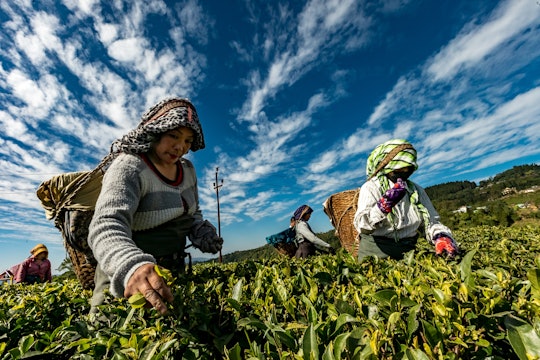
Photo by BBH Singapore on Unsplash
We need genetic engineering to stave off climate change-induced global hunger
Despite what many say, organic farming will not save us from the worst impacts of climate change
Last week the Intergovernmental Panel on Climate Change (IPCC) released its Special Report on Climate Change and Land, a document authored by 107 experts from 52 countries. It warned that “Land is a critical resource."
The main conclusion of the report is that humans already use nearly half of the planet’s land for food production and, as global population levels rise, agricultural land is going to be in very short supply. This is because one of the effects of climate-change will be a decline in agricultural productivity across the tropics, meaning that we will need to cut down forests and convert unused land into farmland. This deforestation will lead to even more carbon emissions, culminating in a vicious cycle of increasing warming.
The report is a frightening 1,400 page-long prediction of rising food costs and starvation of the world’s poor. In fact, behind all the numbers and probability estimates is one truth that carries throughout — that climate change is going to be especially hard on the poor and on people living in the tropics. The IPCC concludes that as carbon dioxide levels rise and the planet warms, farms in temperate latitudes (i.e. the wealthier countries of Europe and North America) will in fact see an increase in yields.
The real damage will occur in the Global South, reducing fruit and vegetable production, causing a decline in the amount of available calories and in the nutritional quality of food available to the world's most at-risk populations. The report concludes that the yields of some vegetables will decline by as much as 30%, and that between 30 and 60% of bean-producing farmland and up to 40% of banana-growing regions in Africa will no longer be viable by the turn of the century.
As a result, the report says that up to 183 million more people will be at risk of hunger due to climate change and consequent rising food prices. However, in a particularly horrifying graph, the report also finds that the solutions we need to mitigate climate change will themselves lead to a ~20% increase in hunger in Africa, southeast Asia, and India. There just isn’t any good outcome here for people living close the equator — people who number three billion human beings, including most of my family.
And that’s why I came away from the report more frustrated than ever with mainstream public environmentalism and what one policy expert has called, “the empty radicalism of the climate apocalypse."

Banana-growing regions of Africa will be hit hard by climate change.
Arminas Raudys on Pexels
One example of this is the modern environmental movement's love affair with organic farming. Organic farming doesn’t even feature once in the chapters of the IPCC report dedicated to food security. This is because it is one of the very worst ways of farming if your objective is to conserve land. In 2017, researchers working at the Research Institute of Organic Agriculture in Switzerland (an organization partly funded by the organic industry) found that if the world converted completely to organic agriculture, we would need between 16 and 81% more land to feed the planet.
What can help reduce agriculture’s global footprint? One solution that appears frequently in the IPCC report is “genetic improvement” of crops. The report highlights that increasing food productivity through technological solutions like “new cultivars from breeding or biotechnology” will be an important part of climate change adaptation. In fact, the report explicitly mentions genome-editing crops using CRISPR-Cas9, the very genetic tool that a European court decided to ban just last year and that major environmental NGOs like Greenpeace and the organic farming community oppose on ideological grounds.
It is this fixation on ideological purity by parts of the environmental movement that I take issue with, and that is incompatible with the recommendations of the IPCC. After describing the dire state of global land-use, the latest report also provides some hope by presenting 40 different means of preventing over-use of land due to climate change, eight of which could provide the most benefits. Some of these include measures like maintaining soil health that are common in organic farms. However others like managing cattle-grazing pastures (which can actually sequester carbon) and the genetic improvement of crops are anathema to everyday environmentalism and run counter to organic dogma.
To be fair, some environmentalists say they oppose genetic engineering as part of a general disgust with companies like Monsanto. I find this argument disingenuous. When the IPCC identifies genome editing as a way to adapt to climate change by creating heat and drought-tolerant crops, no agricultural researcher really expects this challenge to be met by Monsanto or DuPont or any of the large multinational seed companies. For one, these companies simply don’t have large market interests in the countries and kind of crops that will be most affected by climate change. This argument also places the developed world and its industries at the center of climate change policy, distracting from the urgency with which the Global South needs new climate-resilient crops.

Climate-ready crops could help ease the suffering of millions of people in the future
Photo by Markus Spiske on Unsplash
Instead, scientists like me want climate-change ready crops to be developed and distributed for free by publicly-funded trans-national organizations like the CGIAR network, the group behind the Green Revolution that has already had a greater impact on food-security in the tropics than all the large private seed companies combined. And due to the ease of using new genetic tools, we are already seeing such innovation in crop engineering happening in publicly funded labs around the world: from cassava plants making better starch, banana and eggplant resistant to a deadly disease, to rice enriched with vitamins and micronutrients. The vision scientists like me have for climate-smart agriculture includes publicly-funded genome-edited crops developed by our colleagues in local countries, using local crop varieties and compatible with low chemical-input forms of agriculture. This is a vision that I think deserves support from the environmental movement and by the organic farming community, and as the IPCC points out, is necessary if we’re to adapt to climate change.
One common strand that runs through the IPCC report is the importance of compromise and of deploying a combination of diverse solutions to tackle the problem of climate change and land. In Chapter 1, the report flatly says, “none of these response options are mutually exclusive”, and they really needn't be.
According to the IPCC, we need to combine biotechnology with soil stewardship, to better manage grazing lands while reducing red meat consumption, and to tax greenhouse gas emissions but also prevent them from raising food costs. Instead, activists prescribe childishly quixotic solutions like turning entirely to veganism or to buying only organic produce, that turns climate discourse into a constant battle, pitting cattle farmers against Impossible Foods or plant scientists against organic farmers.
This latest IPCC report reads like an advance obituary for millions of humans living in the tropics. I believe that unless the environmental movement changes course, it will simply have helped write the eulogy.



Such an important article, thanks for helping summarize such an extensive IPCC report. I think you’re right - the key to moving towards a positive climate future requires a combination of multiple farming strategies. In order to achieve a more holistic approach to farming, societally we should move the emphasis away from labels like “organic” and “GMO” and instead value sustainable farming methods such as crop rotation, limited pesticide usage, and cover crops - methods that are not embraced by conventional monoculture farms (organic or non-organic). Ultimately, if we are unable to protect the soil and the bees, then no method of farming will be be viable. I agree that utilizing GMOs for more nutritious, drought resistant crops is important for efficient and sustainable crop production, and add that we should also encourage alternative, non-monoculture methods for farming these crops in order to rebuild/sustain the health of our farmable soils long term.